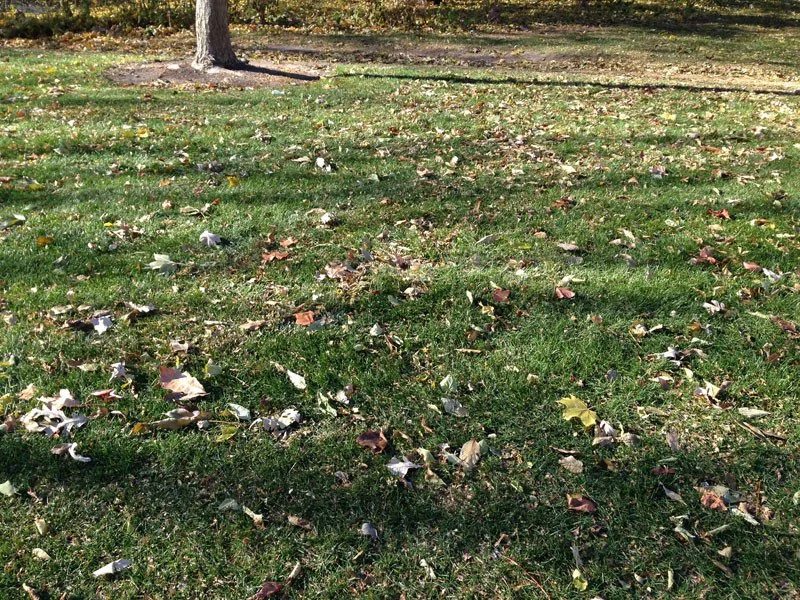Sustainable Fall Cleanup
Winter is coming! With leaves starting to fall and plants going into dormancy, we are beginning to prepare our gardens for the colder months. The most common way that people have learned to clean up their gardens is to rake and remove all of the leaves from their garden beds, lawns, and patios, along with cutting perennial plants down to the ground. However, with further research into the importance of soil organic matter and of pollinator behaviors, it has become clear that this is not the most ecologically friendly way to clean up your garden. Don’t fret if this is how you have prepped your landscape in the past. Decide to try a new approach in 2025!
Read on below to learn about how Green Urb Gardens has taken a more sustainable approach to “fall clean up,” and what you can expect from our crew over the coming weeks. (Spoiler alert: it will be less work than our previous clean-up practices!)
Leave the Leaves
Raking and removing fallen leaves is an extremely common practice, especially in American culture. One might rake their lawn and garden beds for aesthetic reasons and/or to prevent snow mold diseases in the landscape. However, research has found that for the majority of cases, raking leaves generates more damage than benefits to the ecosystem that is your yard. Local non-profit group, Grow Native Massachusetts, says that fallen leaves are among the most under-appreciated garden resources out there.
When fallen leaves start to decompose, they return nutrients to the soil, allowing for richer, more biodiverse soil, which in turn benefits the health of your plants. The organisms that break down the leaves form a complex and vibrant food web, and are an important food source for birds. Additionally, decomposing leaves insulate the ground, helping to protect the roots of shrubs and trees from freezing. All of these benefits come from you doing, well… nothing!
If leaves are piled up multiple feet thick in one area, it is a good idea to spread them out evenly so they can decompose more efficiently, but on many properties, we have found that leaving them alone is best! Our crew will use their best judgement when it comes to spreading out your leaves or letting them lie as is in your gardens.
Another enormous benefit and critical reason to leaving the leaves on the ground is that leaf litter is used as a home for butterflies, bees, moths, pill bugs, fireflies, and more over the winter (source: Xerces). Leaf cleanup can have dire consequences for the insects planning to overwinter in them, sending them almost certainly to their death. Please be a considerate neighbor and help keep their home safe and intact!
We have just two exceptions for leaving the leaves…
Remove excessive leaves on lawns (or mow them if we’re able) and from ground cover plants so as not to smother them.
Remove certain diseased leaves from the landscape, that are most susceptible to re-infecting plants again next year. That includes removing as many of the following leaves as you can: Maple with Tar Spot, Crabapple with Apple Scab, Lilac with Leaf Blotch, and Pear with Entomosporium.
Shredding Leaves
There are some cases where it might be impossible for you to keep the leaves where they are, for instance, on your lawn. According to the University of Minnesota, if leaves are covering more than 20% of a lawn, the grass might be in danger of smothering or molding. In this case, you can still put the rake down. Instead, use your lawn mower or a shredding machine to cut up the leaves! Shredding should be a last case scenario - it can harm the bugs that we discussed earlier that may already have made their home in your leaves.
Our crew will be shredding leaves with an electric shredder this year, where necessary, and putting those recycled leaves back into your garden beds as light, nutritious mulch!
Mow the leaves into your lawn when they cover around 20-40% of the grass. Do not allow the leaves to pile up more than this, as it will not be practical to mow that many leaves into the lawn at once.
The photo to the left here is a good example of when you CAN just leave the leaves on your lawn without concern of causing any damage to your grass.
Photo: Sam Bauer
Cutting Stems
The last thing you can do to make your fall cleanup beneficial to the environment is to cut your dying perennials to 1-2 feet tall, instead of cutting them all the way to the ground. Many pollinators like bees and wasps tunnel into stems or use already hollow stems to build their nests and lay eggs in the following year, allowing for them to make it safely to the next season.
Plants to cut back in this fashion include: Sedum, Joe Pye Weed, Ironweed, Bee Balm, Gayfeather, and Cutleaf Coneflower - click this link for a larger list of plants that pollinators use. Our crew will be cutting these taller (or floppier) plants for this reason.
For plants with seed heads that birds and other wildlife feed on, waiting until late winter or early spring to trim stems will give them ample time to feed, increasing the number of species supported. Those plants include: Black-eyed Susan, Purple Coneflower, Goldenrod, Asters, Helenium, and many other plants, some which are listed here. You will see that our crew has left these shorter, sturdier flower stems and seed heads standing in your gardens this winter so that they may feed the local birds.
Thank you for contributing to a more ecologically sustainable world by supporting our practices at Green Urb Gardens!
Sources:
https://grownativemass.org/Great-Resources/gems-e-news/Leaving-Your-Leaves
https://xerces.org/blog/leave-leaves-these-invertebrates-depend-on-it
https://turf.umn.edu/news/do-you-really-need-rake-all-your-leaves-update
https://www.pittcountyarboretum.com/blog/dont-dead-head-your-fall-perennials
https://www.backyardgardenlover.com/perennial-seed-heads-that-feed-birds-over-winter/
Edited by: Meghan O’Connell

